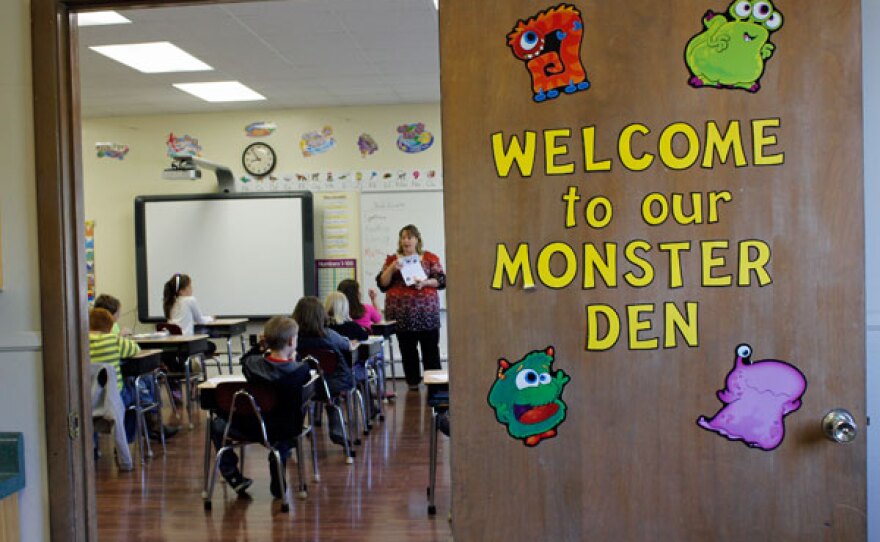When Lauren Wieland graduated from eighth grade this month, there were 3 students in her graduating class.

She was one of 32 students attending Zion Lutheran School, a two-room schoolhouse in Lone Elm, near Boonville.
When the school opened in 1896, it had only one room. It turns out, there are many one-room schoolhouses that still dot the landscape of rural Missouri today.
In the 1960s, Zion Lutheran got its second classroom. That’s also when the school got bathrooms – until then, it had old-fashioned outhouses.
For many of the students – there are usually between 28 and 38 each year – the school is part of their family history.
Wieland said her family has been attending Zion Lutheran School for three generations. Not only did she and her sisters go there, but also her dad and his siblings, and her grandpa before that.
Other students have similar stories, and teacher Marcia Toellner knows them well. She started teaching at Zion Lutheran School in 1975.

“A couple of the kids I have now, I had their parents in school,” she said.
Toellner started out in the younger classroom, teaching the first, second and third-graders. She later switched to the older classroom to teach fourth through eighth grade.
“Sometimes, it’s chaotic,” she said, and laughed.
But she’s used to it. Toellner did her student teaching in St. Louis, but other than that, teaching in this two-room school is all she’s ever done.
“The kids are really good about working on their own,” she said. “They have to become independent quickly. But sometimes, yeah, it gets kind of crazy when you’re trying to teach one subject and another one’s asking [questions]. I’ve got to be able to multitask.”
For a typical lesson, Toellner will go through one subject with each grade level, then move on to the next subject and do the rotation again, fourth through eighth grade.
For fourth-grader Anna Thompson, being in a class with the older kids is a good way to see what she’ll be doing in just a few years – even though it doesn’t always look fun.
“It’s kind of interesting to hear about other people’s work – to see what it would be like to do it someday,” she said. “But the thing I don’t want to do most is algebra. That’s going to be totally hard for me, since I don’t really like math.”
She enjoys getting to know the older students and becoming friends with them.
The older students can also help out with the younger ones. If students in the fourth through eighth classroom finish their work early, they’ll sometimes go into the younger classroom to help with reading or other activities.
Both Toellner and Petree said the students become like family to one another.

Andrea Petree, the teacher in the first, second and third-grade room, rotates through her lessons kind of like Toellner does, but in a slightly different order. She’ll sometimes get the second and third-graders started on a lesson, and while they do a worksheet, she’ll focus on the first-graders.
With grade levels combined and the emphasis on independence, it might seem like there’s not much time for student-teacher interaction.
But actually, the opposite is true.
Maya Farr, an eighth grader, said one-on-one time is one of the perks of Zion Lutheran School. She went to school somewhere else until fifth grade, so she’s got something to compare to.
“We get more one-on-one time with the teacher,” she said. “So, I guess that makes it easier to do our work, because we get it explained to us, rather than her just explaining it to the class, and then moving on to the next class of eighth graders.”
Teachers also get a longer than usual time span with their students – multiple years, instead of just one.
“I get to know my students so well,” Petree said. She used to teach at a bigger Lutheran school in Springfield, then came to Zion Lutheran School two years ago.
“Most teachers, you get your students for one year, and then they move on to the next one, and then, you know, you may pass them in the hall, or say hi now and then … but this, I get to see the development.”
There are also challenges to being at such a small school. Petree said as a teacher, it can get lonely at times, because there’s not the same camaraderie as there would be in a larger school – there aren’t other teachers to talk to at recess, for example. She and Toellner will chat a little at the end of the day, but that’s about it.
At the same time, Petree said, there’s more flexibility.
But the biggest challenge isn’t juggling the lessons, or balancing the different age groups. For Toellner, it’s watching the students leave at the end of eighth grade.
“That’s the hard part,” she said, “is letting them go. Knowing they’re going to go onto high school, and hoping they are ready.”

But graduation is not always a permanent goodbye – some of the students attend Zion Lutheran Church, so those relationships will continue.
The pastor of Zion Lutheran Church, Paul Weisenborn, also keeps a close connection with the school. He leads a short chapel service once a week, and he gets to know the students individually, through both the church and the school.
Beyond education, a nurturing care for the students is one of the school’s top priorities.
“The most important thing,” Weisenborn said, “is not only the concern for the student, but to give them the care and concern the rest of the world does not give them.”
This story was produced in partnership with Columbia Faith & Values (ColumbiaFAVS.com).




